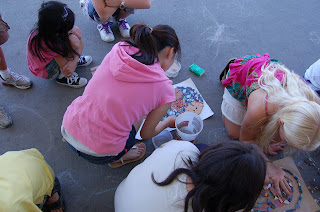My perception of the urban environment as a tool for the use of human society brought me to engage with this project. Eighteen water drop shaped pieces are planned for the pathways and two circular mosaic pieces will mark the entry to the park. The collaboration between planning parties is the driving force behind proper urban management. The result can turn into great living conditions.
How does this relate to making mosaics with the public? When we work on laying each small piece of broken ceramic onto the surface of our concrete base, a personal story unfolds. That story will be viewed by other people who visit the park. They will have a chance to go through a journey into their imagination while walking along the pathways. Already I've had the opportunity to notice the many interpretations some of our finished pieces excite.
 |
| The light gray areas mark the surfaces where the mosaic tiles will be placed. Click the image to zoom in and see the placements for the mosaic tiles. |
The architects have a job to do in designing this park. The builders are in charge of putting it in place. When construction is done, it is the public that will be there to live with the results. Having members of the community participate in putting a piece of their lives into the park is a neat way of tying the ends. Our taxes go into paying for this development. Our hands are still there to be part of building it. It's like baking your own cake instead of buying it in the grocery store.
 |
| These forms will be sunk flush into the concrete surface. The resulting recesses will house the mosaic tiles. |
As simple as making mosaics can be, the fact that they are going to be part of public space requires a degree of coordination that I find intriguing. Each party has a role to perform. By working together the process promotes an opportunity to make the most out of collaboration. Having a community arts project as part of this maintains a balance between the professional and the personal.
 |
| making sense of it all. |









